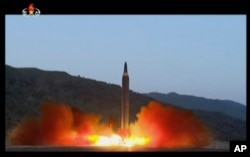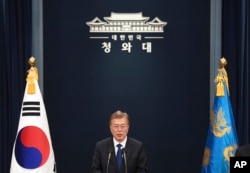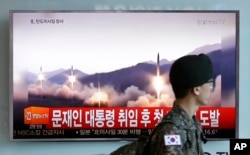North Korea's latest missile launch suggests a major step forward in Kim Jong Un's quest to develop a nuclear tipped intercontinental ballistic missile that could strike the U.S. mainland, analysts say.
Pyongyang claimed on Monday that the missile it fired over the weekend was a "new ground-to-ground medium long-range strategic ballistic rocket" capable of carrying "a large, heavy nuclear warhead."
The missile, dubbed the Hwasong-12, was launched at a high trajectory on Sunday, reaching an altitude of 2,111.5 kilometers and traveling 787 kilometers before landing in the sea near Russia, the North's official news agency KCNA reported.
"The test-fire proved to the full all the technical specifications of the rocket," KCNA said. "It also verified the homing feature of the warhead under the worst re-entry situation and accurate performance of detonation system."
Technical progress?
South Korea's military, however, minimized the Kim regime's claim of technical progress in re-entry technology, which, if successful, allows a warhead to reach its target without burning up while re-entering the atmosphere. The military said that although more analysis is required to verify the North Korean claim, "we believe the possibility of that is low."
North Korea has made no secret of its desire to develop an ICBM capable of delivering a nuclear warhead to the U.S. mainland, but many had believed it was far from mastering the re-entry technology needed for perfecting an ICBM, which uses similar engineering in early flight stages.
The Trump administration has made stopping the development of a North Korean ICBM a top priority, and stressed the U.S. would consider military action to take out launching sites and nuclear facilities, if needed.
Jonathan McDowell, an astrophysicist at the Harvard Smithsonian Center for Astrophysics, told VOA that "this is definitely a step toward an ICBM technology, so I find this kind of launch much more concerning than the satellite launches."
Advanced capabilities
If North Koreans had fired the missile at a lower angle, rather than "almost straight up, … it would have gone maybe as much as 4,000 kilometers, and that is not technically an intercontinental [ballistic missile], but it's still a longer range" than any North Korean missile had previously tested.
McDowell said the increased velocity and altitude and the range of the launched missile, which appeared to be an improved version of the mid-range Musudan model, indicate that the communist state might have advanced its missile capabilities through its test launches over the years.
Similar assessments came from aerospace engineering specialist John Schilling, who wrote on the website of 38 North, a monitoring project based in Washington, that the missile test represents "a level of performance never before seen from a North Korean missile."
The test seems to have not only "demonstrated an intermediate range ballistic missile that may enable the regime to reliably strike the U.S. base at Guam in the Pacific," Schilling said, but "more importantly, may represent a substantial advance to developing an intercontinental ballistic missile."
An early test for Moon Jae-in
The North Korean missile test occurred days after Moon Jae-in, of the liberal Democratic Party of Korea, was sworn in as the president of South Korea, replacing his conservative predecessor Park Geun-hye, who was recently ousted in a corruption scandal. Moon campaigned on a promise to engage North Korea, in contrast to Park, who was bent on cutting all ties to the reclusive regime.
"We should understand that just because a liberal president has been elected, it doesn't mean that Pyongyang is going to suddenly stop testing," Ken Gause, director of the International Affairs Group at the Center for Naval Analyses, told VOA. "This launch could be designed to see how Moon Jae-in reacts."
Kim is testing Moon to determine whether he is going to interact with the U.S. and China and seek refuge in the alliance as part of a united front against North Korea, or if he is going to reach out to Pyongyang in an effort to seek an inter-Korean solution, Gause said. "Knowing these answers will help Kim Jong Un calibrate his foreign policy toward the new administration in Seoul."
Test could lead to talks
Alan Romberg, director of the East Asia Program at the Stimson Center, reads Pyongyang's launch of the latest missile as a gesture to encourage South Korea's newly elected president to contact the regime.
"North Korea does not believe that adopting soft or accommodating positions is the best way of inducing dialogue, but rather sees demonstrations of strength as most likely to eventually produce the negotiated outcomes it wants," Romberg said in an email to VOA.
In response to Sunday's launch, Moon strongly condemned North Korea, saying there still remains the possibility of a productive inter-Korean dialogue but that the South would deal rigorously with any such provocation.
Jenny Lee contributed to this report.








